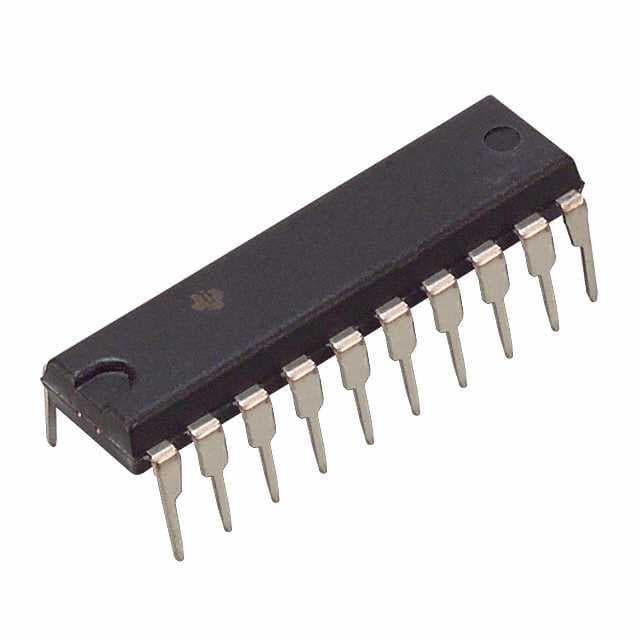Lihat spesifikasi untuk detail produk.

SN74LS645-1N
Product Overview
Category
The SN74LS645-1N belongs to the category of integrated circuits (ICs).
Use
It is commonly used in digital electronic systems for data bus transceivers.
Characteristics
- The SN74LS645-1N is a bidirectional octal transceiver.
- It operates on a voltage range of 4.75V to 5.25V.
- It has a high-speed performance with a maximum propagation delay of 10ns.
- The device is designed to handle both TTL and CMOS logic levels.
- It offers a wide operating temperature range of -40°C to 85°C.
Package
The SN74LS645-1N is available in a 20-pin DIP (Dual In-line Package) format.
Essence
This IC acts as a buffer, allowing bidirectional data transfer between two separate data buses.
Packaging/Quantity
The SN74LS645-1N is typically packaged in tubes or reels, with quantities varying based on customer requirements.
Specifications
- Supply Voltage: 4.75V to 5.25V
- Operating Temperature Range: -40°C to 85°C
- Logic Family: LS-TTL
- Number of Pins: 20
- Maximum Propagation Delay: 10ns
Detailed Pin Configuration
The pin configuration of the SN74LS645-1N is as follows:
+---\/---+
A0 -|1 20|- VCC
A1 -|2 19|- B7
A2 -|3 18|- B6
A3 -|4 17|- B5
A4 -|5 16|- B4
A5 -|6 15|- B3
A6 -|7 14|- B2
A7 -|8 13|- B1
GND -|9 12|- B0
OE -|10 11|- DIR
+--------+
Functional Features
- Bidirectional data transfer between two separate data buses.
- TTL and CMOS compatible logic levels.
- High-speed performance with low propagation delay.
- Wide operating temperature range for versatile applications.
Advantages and Disadvantages
Advantages
- Allows efficient bidirectional data transfer.
- Compatible with both TTL and CMOS logic levels.
- Offers high-speed performance.
Disadvantages
- Limited to a specific number of data lines (octal configuration).
- Requires careful consideration of voltage levels and compatibility.
Working Principles
The SN74LS645-1N functions as a bidirectional transceiver by enabling data transfer in both directions. It utilizes control signals, such as the Output Enable (OE) and Direction (DIR) pins, to determine the direction of data flow. When the DIR pin is set to a specific logic level, the data is transferred from one bus to another. The OE pin controls the output enable/disable state of the device.
Detailed Application Field Plans
The SN74LS645-1N finds application in various digital systems where bidirectional data transfer is required. Some common application areas include:
- Microprocessor-based systems
- Data communication networks
- Industrial automation
- Embedded systems
- Telecommunications equipment
Detailed and Complete Alternative Models
There are several alternative models available that offer similar functionality to the SN74LS645-1N. Some notable alternatives include:
- SN74LS245: Octal bus transceiver with tri-state outputs.
- SN74HCT645: Octal bus transceiver with 3-state outputs.
- SN74HC645: Octal bus transceiver with 3-state outputs and higher speed performance.
These alternative models provide options for different logic families, output configurations, and performance characteristics, allowing users to choose the most suitable option for their specific requirements.
In conclusion, the SN74LS645-1N is a bidirectional octal transceiver IC used in digital electronic systems. It offers high-speed performance, compatibility with TTL and CMOS logic levels, and efficient data transfer between two separate data buses. With its wide operating temperature range and versatile applications, it serves as a reliable component in various industries.
Sebutkan 10 pertanyaan dan jawaban umum terkait penerapan SN74LS645-1N dalam solusi teknis
Sure! Here are 10 common questions and answers related to the application of SN74LS645-1N:
Q1: What is SN74LS645-1N? A1: SN74LS645-1N is a type of integrated circuit (IC) commonly used as a bus transceiver. It allows bidirectional data transfer between two buses with different voltage levels.
Q2: What is the voltage range supported by SN74LS645-1N? A2: SN74LS645-1N supports a voltage range of 4.5V to 5.5V.
Q3: How many channels does SN74LS645-1N have? A3: SN74LS645-1N has 8 bidirectional channels, allowing simultaneous data transfer in both directions.
Q4: What is the maximum data transfer rate of SN74LS645-1N? A4: The maximum data transfer rate of SN74LS645-1N is typically around 25 MHz.
Q5: Can SN74LS645-1N be used for level shifting between different voltage domains? A5: Yes, SN74LS645-1N can be used for level shifting between voltage domains, making it suitable for interfacing between systems with different voltage requirements.
Q6: Does SN74LS645-1N require external pull-up or pull-down resistors? A6: No, SN74LS645-1N has built-in pull-up and pull-down resistors, eliminating the need for external components.
Q7: Can SN74LS645-1N handle bus contention? A7: Yes, SN74LS645-1N has built-in bus-hold circuitry that prevents bus contention during simultaneous data transfers.
Q8: Is SN74LS645-1N compatible with TTL logic levels? A8: Yes, SN74LS645-1N is compatible with TTL (Transistor-Transistor Logic) logic levels.
Q9: Can SN74LS645-1N be used in both parallel and serial communication systems? A9: Yes, SN74LS645-1N can be used in both parallel and serial communication systems, depending on the application requirements.
Q10: What are some common applications of SN74LS645-1N? A10: SN74LS645-1N is commonly used in data buses, address buses, memory interfaces, and other digital systems where bidirectional data transfer between different voltage domains is required.
Please note that these answers are general and may vary based on specific design considerations and requirements.

